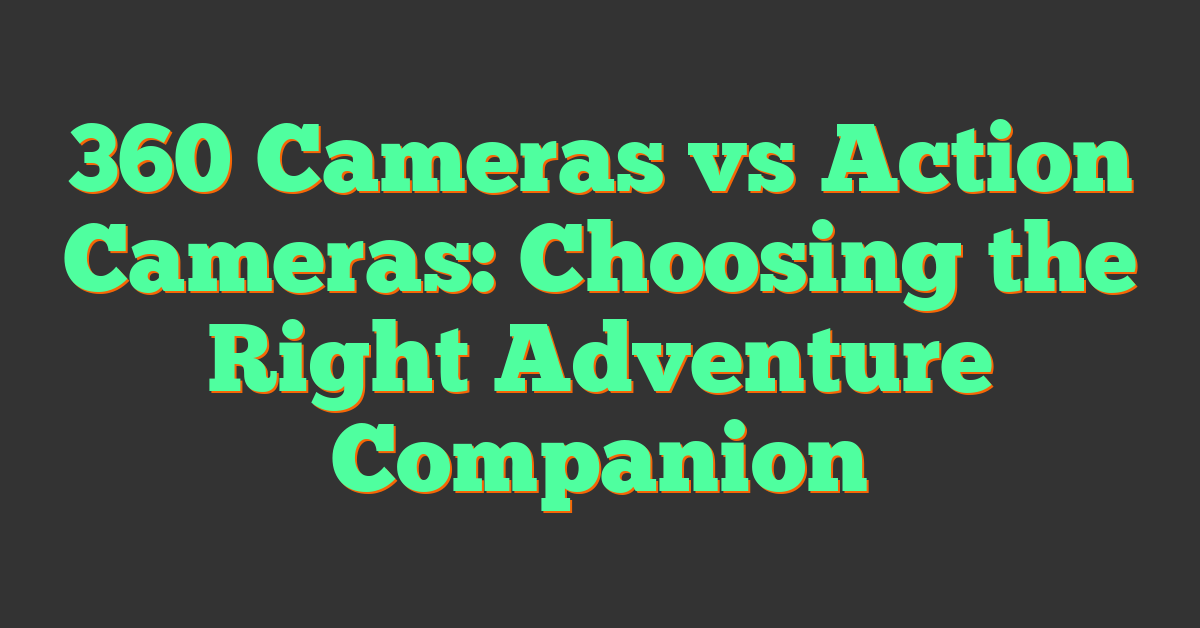When deciding between a 360-degree camera and an action camera, it’s essential to understand their distinct features and how they can cater to your needs as an enthusiast or professional content creator. A 360-degree camera captures every angle of a scene in a spherical range, providing an immersive experience that puts viewers at the center of the action. These cameras can capture content in a way that allows for interactive virtual reality experiences and panoramic shots. In contrast, action cameras are built to handle extreme conditions and are often used to capture high-intensity activities due to their rugged design, compact size, and straightforward functionality.
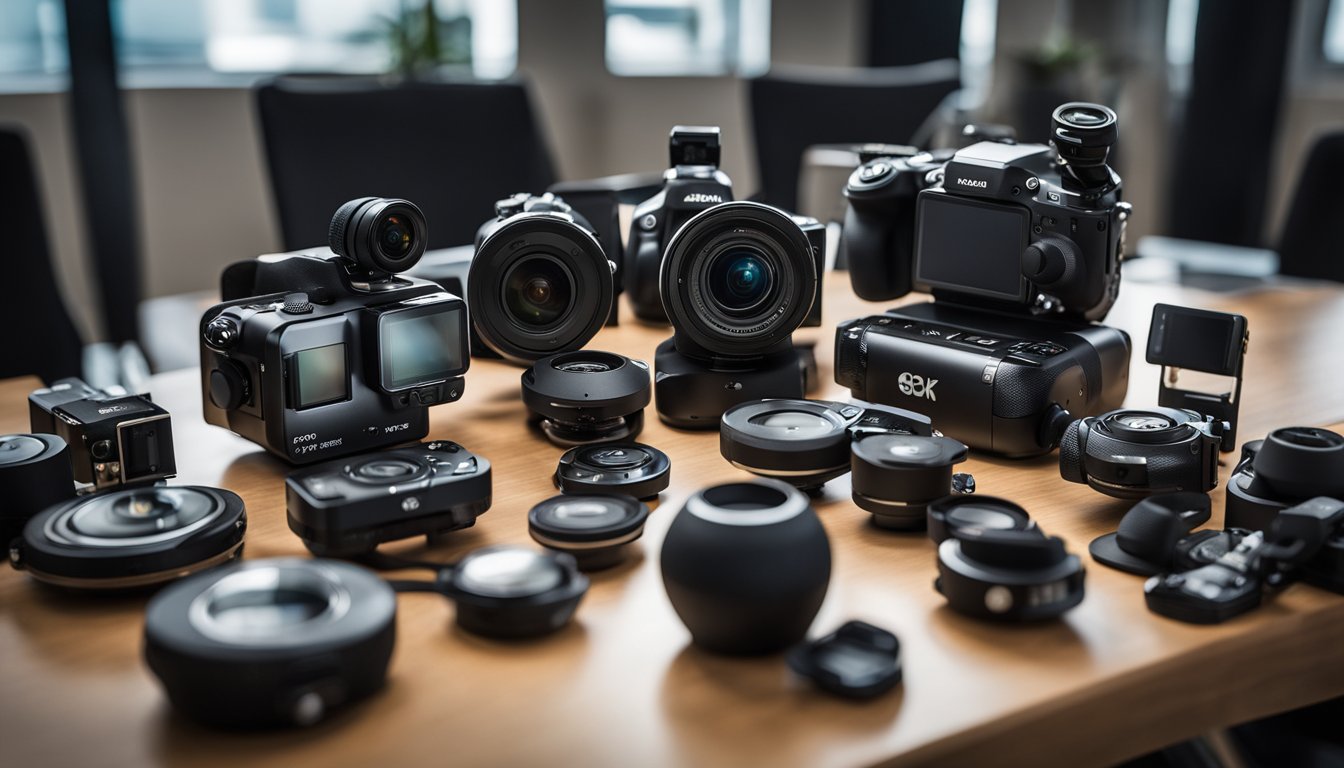
The choice between these two types of cameras depends on what you’re looking to shoot. If you’re after high-resolution, all-encompassing footage that can be experienced in a variety of ways, a 360-degree camera might be what you need. However, if durability and the ability to record fast-paced action are your top priorities, an action camera’s robust build might be more appropriate. The decision also hinges on factors like ease of use, available accessories, and the particular use case you have in mind, such as vlogging, sports, or travel.
Key Takeaways
- Immersive 360-degree cameras are ideal for capturing panoramic content and virtual reality experiences.
- Action cameras offer durability and are suited for high-intensity, fast-paced recording activities.
- Choosing the right camera depends on your specific needs for image quality, user experience, and recording conditions.
Understanding the Basics
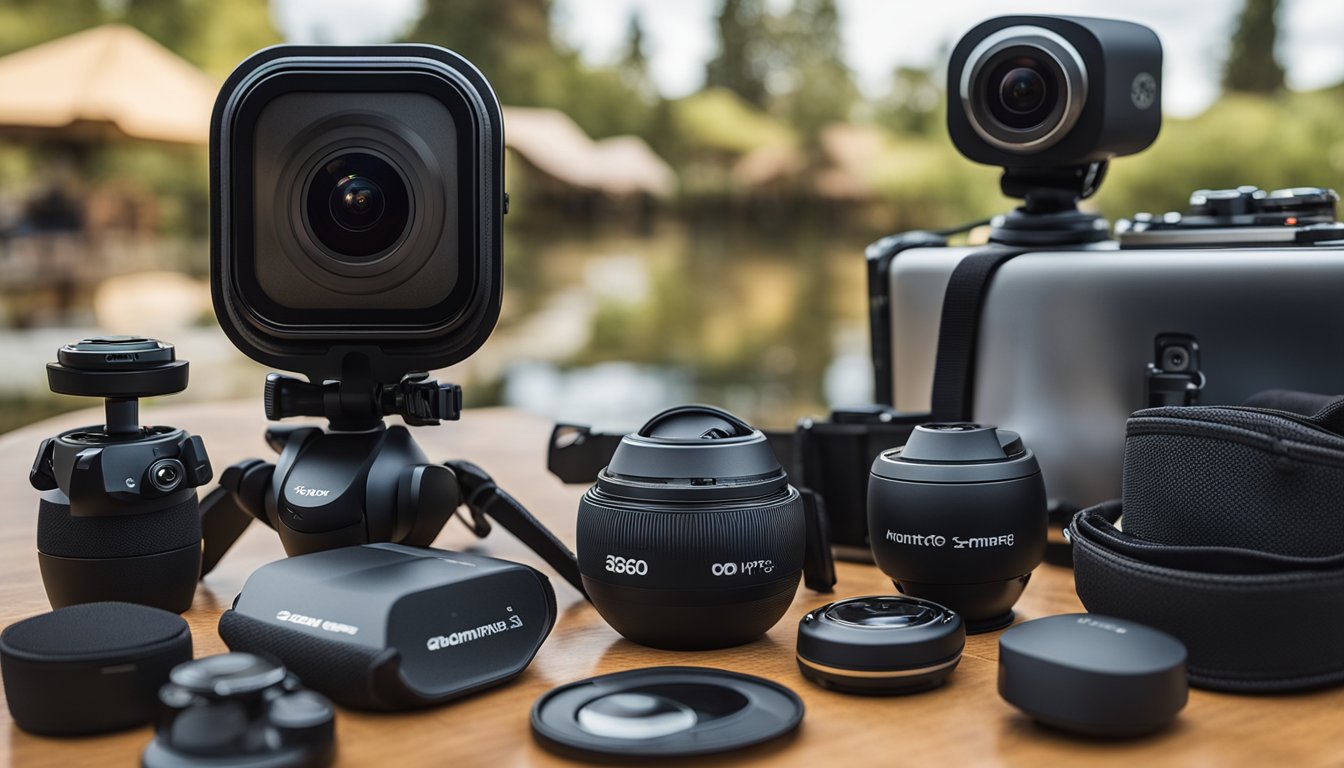
When you’re deciding between a 360 camera and an action camera, it’s essential to know what each offers and how they differ in terms of camera and lens technology.
What Are 360 Cameras?
A 360 camera, often referred to as an omnidirectional camera, captures a 360-degree field of view in the horizontal plane. These cameras are equipped with at least two lenses that record simultaneously, giving you a complete spherical image or video after stitching the footage together. Examples of this technology can help you grasp the immersive experience they offer.
What Are Action Cameras?
An action camera is designed for capturing footage in dynamic scenarios where movement is involved—think mounting on a bike helmet or surfboard. They usually boast a rugged build and are typically water-resistant or waterproof. Action cameras come with a wide-angle lens that captures your exciting adventures with a focus on stability and clarity in challenging conditions.
Camera and Lens Technology
The lens and camera technology behind these devices is quite remarkable:
360 Cameras: Utilize dual fisheye lenses to capture a complete environment. Some models stitch the footage in-camera, while others require software to merge the images into a seamless 360-degree photograph or video.
Action Cameras: Often feature a single wide-angle lens, sometimes with fields of view up to 180 degrees, designed to capture sharp, high-definition images even in rough conditions. They may also include features like electronic image stabilization to keep your shots steady.
Design and Build Quality

When you’re choosing between a 360 camera and an action camera, the design and build quality are crucial aspects to consider. Each type caters to different needs, whether you’re looking for something lightweight and compact or a camera that can withstand the elements.
Size and Portability
360-degree cameras typically feature a slender design, making them highly portable and easy to handle. Many models are small enough to fit in your pocket, which is a huge plus if you want to travel light. On the other hand, action cameras are built to be compact and lightweight as well, but they sometimes prioritize extra features that might add to their weight.
Waterproof and Rugged Features
A standout trait of action cameras is their rugged design. They’re often encased in a rubberized chassis that can absorb shocks and handle drops with little to no damage. Moreover, they are commonly waterproof, which means you can take them underwater without the need for an additional housing, at least up to a certain depth. In contrast, 360 cameras aren’t inherently rugged but some come with waterproof cases or features, making them suitable for mild outdoor activities.
Modular Capabilities
« 360 Cameras with LiDAR: Unveiling the Future of Immersive Photography
360 Camera Business Ideas: Innovative Ventures in Immersive Technology »
Modular design is a newer feature in the world of cameras, and action cameras like the DJI Osmo Action stand out with these capabilities. You can add or remove components such as screens or battery modules depending on your shooting requirements. 360-degree cameras, while not traditionally modular, have recently begun to adopt these features, providing additional flexibility for creative shooting.
Image and Video Capabilities
https://www.youtube.com/watch?v=kelEKmgsauw&embed=true
When you’re comparing 360 cameras and action cameras, the image and video capabilities are crucial. It’s not just about capturing any image or clip; it’s about securing moments with clarity, perspective, and in the best light possible. Let’s explore how these cameras stack up in terms of resolution, coverage, and performance under various lighting conditions.
Resolution and Image Quality
The resolution of a camera is pivotal as it determines the amount of detail your images and videos will have. Most 360 cameras offer 5.7K video which provides astonishing detail, allowing you to zoom in and explore scenes without losing clarity. On the other hand, action cameras often boast about 4K video capability, delivering crisp and lively visuals perfect for your high-octane adventures. If you demand uncompromised image quality, keep an eye out for cameras that feature a 1-inch sensor, as they typically capture superior stills and videos.
360-Degree vs Wide-Angle
With a 360-degree camera, you capture the whole world around you, not just a part of it. These cameras use a dual-lens system to stitch together a complete spherical image, letting you record truly immersive 360-degree videos. Contrast that with action cameras, which provide a wide-angle view that’s perfect for capturing fast-paced activities without the need to manually adjust the frame. This means you’ll get a comprehensive view with a 360 camera but a focused, dynamic shot with an action camera.
Low-Light Performance and HDR
Low-light performance is critical if you’re venturing into the dusk or in other dimly lit conditions. Action cameras often struggle here unless they’re specifically designed with low-light shooting in mind. HDR, or High Dynamic Range, is another feature to consider. It vastly improves video and image quality by balancing the light and dark parts of your footage. Some of the best 360 cameras integrate HDR to ensure that your memories are captured with vibrancy, regardless of lighting challenges.
Functional Aspects
https://www.youtube.com/watch?v=FTKsWqemJog&embed=true
When you’re deciding between a 360-degree camera and an action camera, understanding how they handle functional aspects like battery life, stabilization, and connectivity can greatly influence your choice. Let’s explore these features to see which camera type aligns with your needs.
Battery Life and Storage
360-degree cameras: Generally, they possess moderate battery life, enough for capturing extensive footage. For instance, some models can record up to 60 minutes on a single charge. Storage typically relies on microSD cards, with support for varying capacities depending on the camera model.
Action cameras: They’re often equipped for the long haul with longer battery life—some models can last beyond 2 hours of continuous use. Just like 360 cameras, action cameras also use microSD cards for storage, and high-end models may offer larger internal storage options.
Stabilization and Software Integration
360-degree cameras: Feature both video and image stabilization, which is essential when stitching together 360 footage. The software processing in these cameras is designed to handle complex editing, and a corresponding smartphone app is often available to facilitate on-the-go adjustments.
Action cameras: Renowned for robust video stabilization, making them ideal for capturing fast-paced activities. Software integration is advanced, with many models offering automatic editing features in their companion apps, allowing for quick sharing of polished content.
Connectivity and GPS Functionality
360-degree cameras: Most come with Wi-Fi connectivity, enabling you to stream content directly to your devices or the internet. Some models also integrate GPS for geotagging, which is a bonus for mapping your adventures.
Action cameras: They typically boast superior connectivity options, including Wi-Fi and Bluetooth, sometimes even live streaming capabilities. GPS functionality isn’t universal but is present in higher-end models, offering insights like speed and elevation for your activities.
Usability and Accessories
When choosing between 360 cameras and action cameras, consider how easy they are to use and the range of accessories available that can enhance your filming experience. Whether you’re vlogging or engaging in outdoor activities, the right setup can make a significant difference.
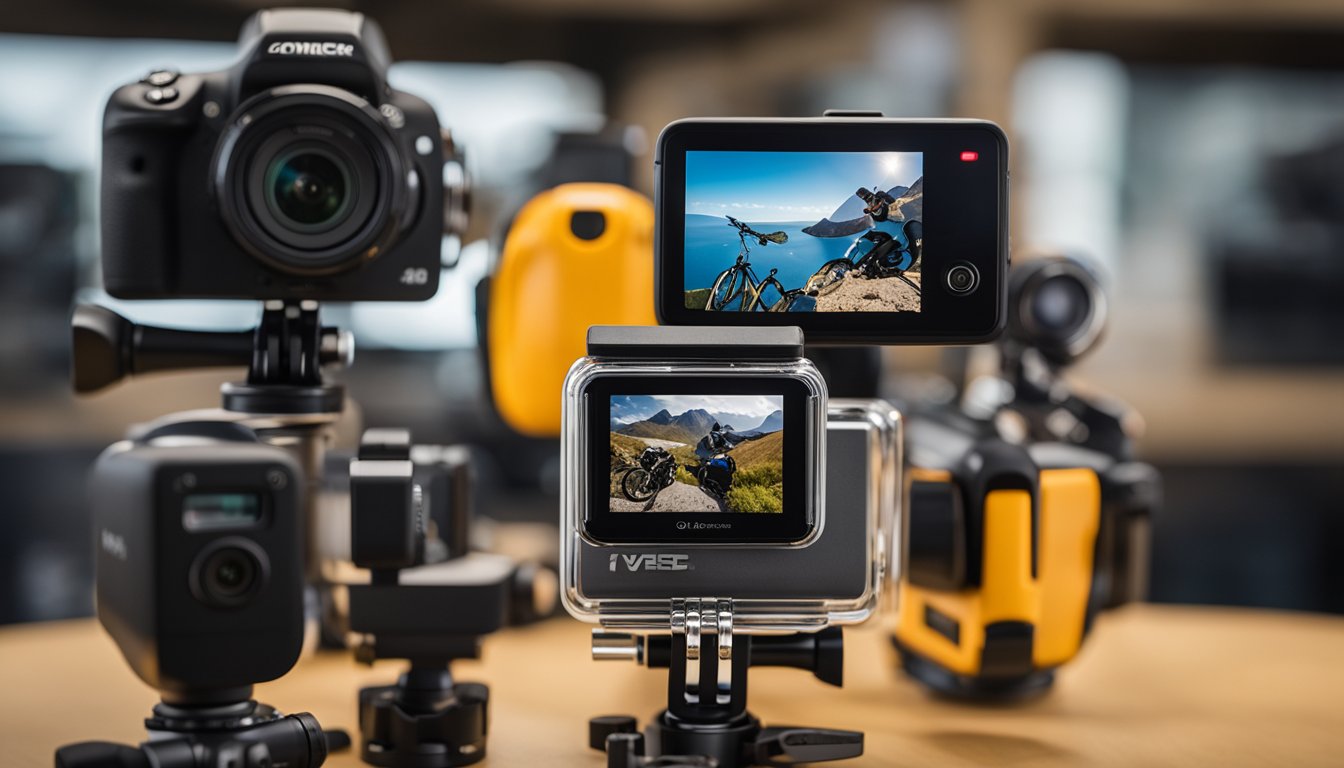
Ease of Use
360 cameras offer a unique way to capture everything around you, which makes them exceptional for immersive experiences. They often come with software that simplifies editing and sharing, so you don’t need to be a professional to create compelling content. On the other hand, action cameras are designed for quick and easy operation, usually with a one-button start for capturing footage on the go, ideal if simplicity is key in your adventures.
Accessory Ecosystem
The accessory ecosystem for both 360 cameras and action cams has grown substantially. You can find a variety of add-ons to enhance your camera’s functionality. For 360 cameras, there are specialized accessories that ensure the mounts are invisible to provide a seamless recording experience. In contrast, action cameras boast a diverse range of accessories designed for extreme conditions, including waterproof cases and various mounts for attaching to helmets, bikes, and other gear.
Mounting and Tripod Options
Mounting flexibility is paramount in capturing the perfect angle. Tripods and other mounts allow you to secure your camera for stable shots. Action cameras have a standardized tripod thread which makes them compatible with a vast selection of mounts and tripods. For those into vlogging or creating smart home setups, certain tripods offer more versatility to connect not only your camera but also other devices like phones. Meanwhile, 360 cameras might require proprietary mounts to avoid disrupting the 360-degree field of view.
Specific Use Cases

When you’re deciding between a 360-degree camera and an action camera, consider what you’ll be recording. Each type excels in different scenarios, from the rush of a mountain bike descent to the sprawling views of a travel adventure.
Sports and Adventure Recording
For adrenaline junkies and sports enthusiasts, action cameras are the go-to choice. They are rugged, compact, and offer a stable, high-resolution recording, essential for capturing fast-paced actions. Features like active HDR ensure that your footage is clear, even in varying outdoor lighting conditions. Brands like GoPro are synonymous with these scenarios, providing you with durable equipment that can handle knocks and falls.
Travel and Vlogging
If you’re a travel vlogger, the panoramic shot capabilities of 360-degree cameras might be more appealing. These cameras allow you to capture more of the environment around you, which can be fantastic for immersive travel content. Plus, the easy-to-use interfaces make them suitable for those moments when you want a quick capture without fussing over settings. For instances where you’re moving and want your audience to be part of the adventure, Insta360 cameras offer a blend of portability and panoramic capability.
Professional Photography and Videography
Professional photographers and videographers often require a blend of both worlds. 360-degree cameras can be used for virtual tours or real estate showcases, providing a comprehensive view of interiors. As for action cameras, their compact size is perfect when they are mounted on drones for aerial videography or difficult-to-reach angles. High-quality action cameras, which offer point-and-shoot simplicity without sacrificing video quality, are ideal for fast-paced professional work where setup time is limited.
Comparing Popular Models
https://www.youtube.com/watch?v=nQCDc-elzts&embed=true
In the diverse camera market, quality and pricing vary greatly. Whether you’re investing in a 360-degree camera for panoramic video capture or an action camera that can brave the elements, it helps to know which models stand out. Here are some of the ones that meet various needs and budgets.
Best Overall Choices
When it comes to best overall choices, the Insta360 X3 shines for its balance of features and quality, and the GoPro Hero11 Black is a testament to GoPro’s dominance in the action camera domain. The X3 offers stunning 360-degree captures, and the Hero11 Black provides impressive image stabilization and 5.3K video.
Budget-Friendly Picks
Your budget-conscious side will appreciate the budget-friendly picks. The Insta360 GO 2 and the DJI Action 2 are commendable for their portability and quality at a reasonable price point. While not as feature-rich as their pricier counterparts, these models deliver on essential functions without breaking the bank.
Top Picks for Tech Enthusiasts
Tech enthusiasts looking for cutting-edge technology can gear up with models like the GoPro Max and Ricoh Theta Z1. These are top picks for those who value the latest advancements. The GoPro Max offers spherical video capabilities and the Theta Z1 stands out with its exceptional image quality — making them stellar choices for the tech-savvy.
Audio and Video Editing
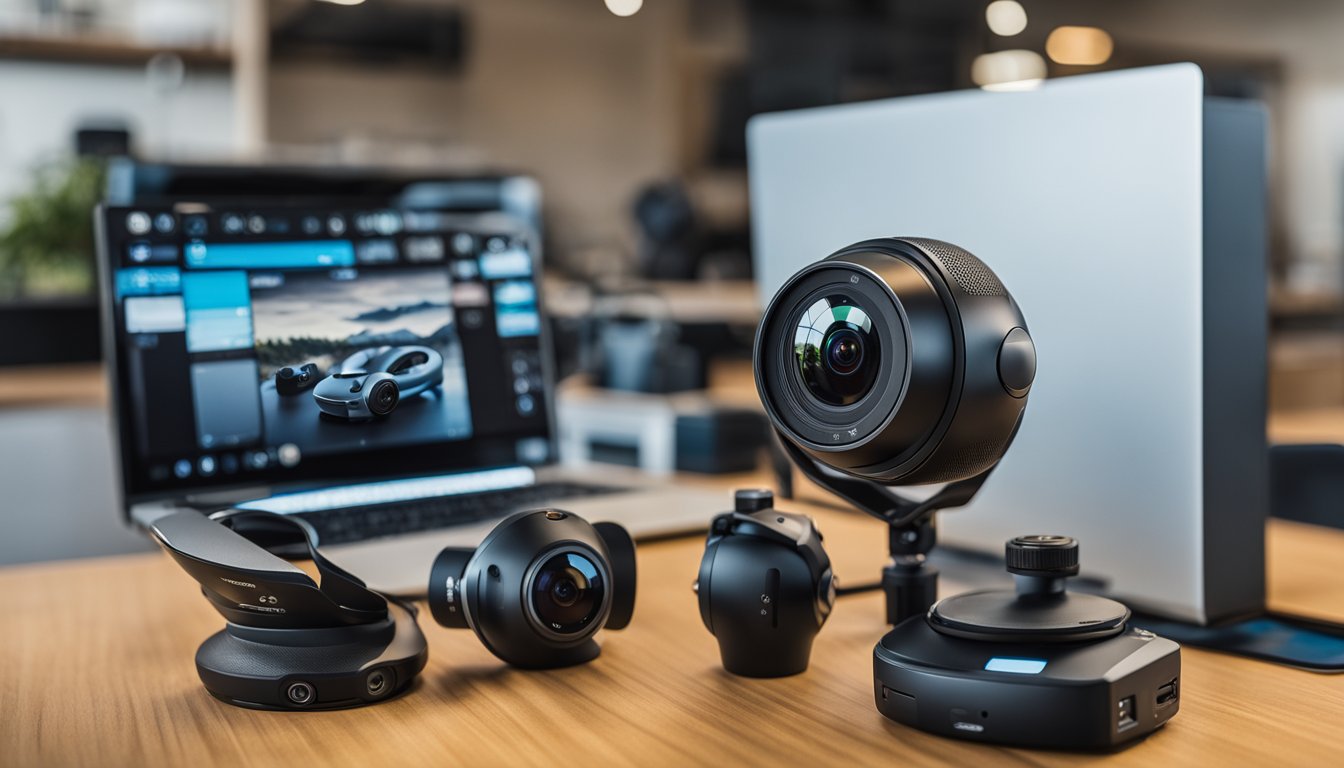
When you’re deciding between 360 cameras and action cameras, it’s important to consider the editing capabilities they offer. Whether it’s the intuitive software for arranging your shots or the stabilization technology that smooths out your videos, the right camera can make post-production a breeze.
Integrated Editing Platforms
GoPro and Insta360 both provide proprietary editing platforms that allow you to quickly fine-tune your footage directly from your camera or smartphone. These often include features like automatic editing templates and AI-powered tools that simplify video and audio adjustments. For instance, GoPro offers Quik, a mobile app designed for easy editing, while Insta360 has its own app that lets you manipulate 360-degree videos with swipes and taps.
Post-Production Quality
After you’ve captured your images and videos, you’ll want to ensure they look their best. Both types of cameras support HD video editing, but with 360 cameras, you have the unique ability to reframe your shot after the fact. This gives you greater creative freedom, as you can choose the angle in post-production. However, when it comes to mirrorless or action cameras, the focus is often on delivering high-definition, stabilized content straight out of the camera.
Sound Capabilities
Your camera’s audio recording quality can make or break your video. Many action cameras, including those by GoPro, are geared towards capturing crisp sound, even in noisy environments. In contrast, 360 cameras like Insta360 might prioritize spatial audio that corresponds with the direction of the video, enhancing the immersive experience. Regardless of your choice, consider additional equipment like external microphones for the best sound capture.
Innovation and Future Trends
https://www.youtube.com/watch?v=UbC-_bODG9Y&embed=true
The landscape of photography and videography is constantly evolving, especially within the tech sphere. As you look into 360 cameras and action cams, it’s exciting to see how they are advancing.
360-degree cameras are pushing the envelope with innovations like 3D and spherical video capabilities. Imagine capturing not just a frame, but the entire environment around you—this is rapidly becoming more accessible and user-friendly. The next generation of these devices promises even higher resolutions, such as 8k, and enhanced image quality across various lighting conditions.
When it comes to action cams, the evolution is equally thrilling. The trend is moving towards sleeker, more mirrorless designs that pack a punch with smart tech. The aim is to create cameras that are not just rugged and compact but also intelligent, with features that allow for easy sharing and editing.
| Feature | 360 Cameras | Action Cams |
|---|---|---|
| Video Quality | Up to 8K, spherical video | High-definition, durable |
| Special Capabilities | 3D imaging, 360-degree video | Rugged design, live streaming |
| Tech Advancements | Dual lens systems | Integrated smart tech |
You’ll likely see more 360 cameras equipped with dual lens systems, providing full 360-degree coverage without the need to stitch images together manually. These cameras are becoming more user-friendly, and their applications range from personal adventures to professional uses like virtual tour creation.
Your experience with these cameras is set to become more immersive and seamless. Whether you’re a professional looking for the next big thing or an enthusiast excited about new tech, the future of both 360-degree cameras and action cams is looking bright and innovative.
Final Considerations
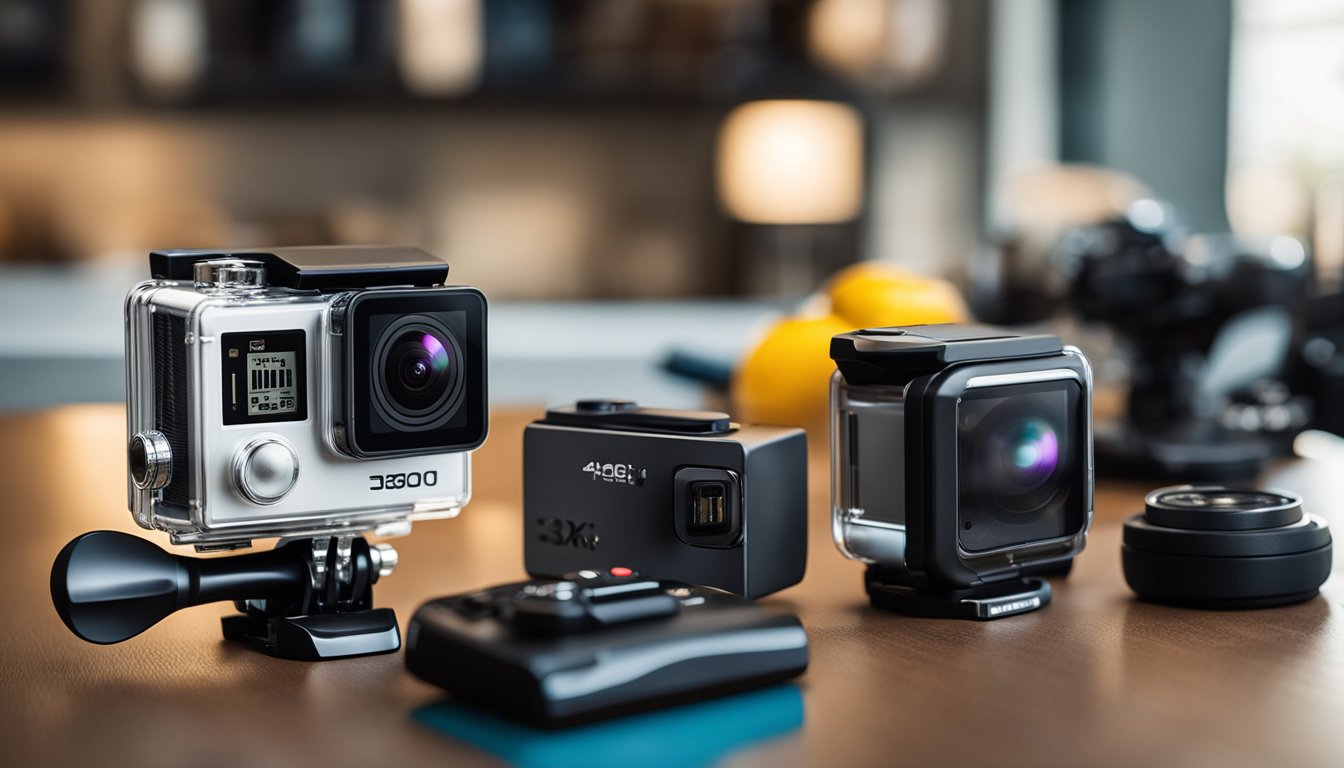
When you’re at the crossroads of choosing the perfect camera to capture your adventures and memories, it’s essential to consider the post-purchase journey, including maintenance, community engagement, and support services.
Deciding on the Right Camera for You
In selecting between a 360-degree camera and an action camera, match the functionality to your needs. A 360 camera, like the Insta360, offers an immersive experience with a comprehensive view of your surroundings. This type of camera is ideal if you love producing interactive videos that allow viewers to control their perspective. In contrast, action cameras excel in durability and resistance, making them the go-to choice for sports enthusiasts and travelers who engage in intense activities and require robust performance from the camera’s build.
- 360 Cameras: Best for virtual tours and panoramic shots.
- Action Cameras: Preferable for extreme sports and high-movement activities.
Maintenance and Care
Your camera’s longevity greatly depends on how well you maintain and care for it. Both camera types benefit from regular cleaning, especially the lens and image sensor, which are crucial for maintaining image quality. Action cameras often come with additional protection against elements, but that doesn’t mean they should be neglected. Modular cameras, such as GoPro’s lineup, might need extra attention due to their interchangeable parts.
- Check for:
- Water damage
- Sand or dust in moving parts
- Condition of casing and mounts
Community and Support
Engagement with a camera brand’s community can provide you with creative ideas, troubleshooting tips, and feedback from fellow users. It’s beneficial to consider the support provided by the brand for your camera of choice. Look into forums, official support channels, and the availability of accessories, which can expand the usability of your camera. Strong community backing could mean a plethora of third-party accessories, which might tip the scales if you’re passionate about customization.
- Join forums or social media groups related to your camera.
- Research the brand’s customer support reviews.
Remember, your perfect camera should align with your activities, be easy to maintain, and come with a supportive community and reliable customer support to enhance your overall experience.
Frequently Asked Questions

In this section, we’ll answer some common inquiries to help you discern the suitability of action cameras versus 360-degree cameras for your needs.
What are the key differences between an action camera and a 360-degree camera?
An action camera is designed for rugged use and typically provides focused wider-angle shots, perfect for point-of-view recording. On the other hand, 360-degree cameras capture immersive video footage in all directions, allowing for interactive panoramas.
Which is better for live streaming: an action camera or a 360 camera?
For live streaming, an action camera often offers high-quality, stable video, making it a great choice for dynamic, first-person perspectives. A 360 camera, however, can offer an immersive experience, allowing viewers to look around within the live feed.
What should a beginner consider when choosing between an action camera and a 360 camera?
If you’re just starting out, consider what you want to capture. For simplicity and ease of use, go for an action camera. However, if you want to experiment with immersive videos and interactive content, consider trying a 360 camera.
Can you list some disadvantages of using a 360-degree camera?
While offering immersive footage, 360-degree cameras can be more complex to operate and require time-consuming post-processing to stitch the footage together, which can be a significant disadvantage for some users.
What makes a 360 camera a worthwhile investment over a traditional action camera?
A 360 camera becomes a worthwhile investment for those focused on creating virtual reality content or interactive videos where viewers can explore any direction in the scene.
Which type of camera is preferred for shooting in 4K, action or 360-degree?
Both camera types are capable of shooting in 4K, but if you’re looking for crisp detail in high-action scenes, a 4K action camera is often preferred. However, a 360-degree camera also shoots in 4K and is ideal if you want a full spherical capture.

